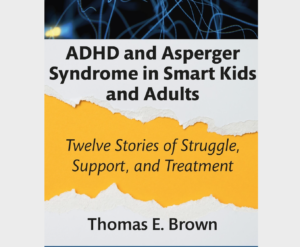 In ADHD and Asperger Syndrome in Smart Kids and Adults: Twelve Stories of Struggle, Support, and Treatment, Thomas Brown shares engaging and informative stories of gifted individuals with ADHD. This series of case studies takes on the traditional definitions and misconceptions of both ADHD and Asperger’s syndrome, focusing instead on how clusters of symptoms including social-emotional skills and an in-depth understanding of the individual’s social environment reveal a fascinating and useful approach to diagnosis and treatment.
In ADHD and Asperger Syndrome in Smart Kids and Adults: Twelve Stories of Struggle, Support, and Treatment, Thomas Brown shares engaging and informative stories of gifted individuals with ADHD. This series of case studies takes on the traditional definitions and misconceptions of both ADHD and Asperger’s syndrome, focusing instead on how clusters of symptoms including social-emotional skills and an in-depth understanding of the individual’s social environment reveal a fascinating and useful approach to diagnosis and treatment.
Brown does not shy away from critiques of the Diagnostic and Statistical Manual of Mental Disorders (DSM) and illustrates his perspective by walking us through several diagnoses and treatments for individuals with these symptoms from across age groups. Particular attention is given to one of the interesting puzzles of ADHD in which the symptoms are situational and not consistently expressed. When an individual is engaged in an activity they are interested in, the symptoms of ADHD seem to subside, and strong executive function may be expressed in that context. As a result, parents, teachers, and individuals with ADHD may inappropriately interpret the attentional and emotion regulation problems as simply a lack of willpower. Throughout each of the cases, Brown demonstrates how the symptoms of ADHD often lead to these types of misunderstandings and how diagnoses can lead to a sense of relief and enable the utilization of medical and psychotherapeutic interventions to manage the symptoms.
What makes Brown’s case studies so important is that he takes an integrated view of ADHD. He argues that an emotional component of the diagnosis is crucial and often neglected. Individuals differ in their emotional regulation problems and these case studies illustrate these regulatory symptoms and their situational nature. Bringing emotional and cognitive features into the same diagnosis criteria connects well with the literature on the fallacy that cognitive skills and emotional skills are separate psychological functions; both rely on the same neural circuitry leading to motivation, regulation, and potential disruption. Pooling together the traditional reliance on regulating focus as a primary symptom with the regulation of working memory, regulation of emotional reactions and frustration, the initiation of effort, self-monitoring, the regulation of actions, and the ability to activate engagement in work rounds out the diagnosis to include the whole person. This is especially useful when teachers or parents view ADHD as a more academic skill and are made aware of how ADHD is a lived experience across life domains.
Important for this text is also a deep impassioned discussion concerning the now absent diagnoses of Asperger’s syndrome which has now been absorbed into the updated diagnosis of autism spectrum disorder. To be honest, this was an area I began to read with a certain amount of trepidation, but the author offers very convincing arguments for the reintroduction of Asperger’s syndrome into the DSM giving me great pause in my preconceived beliefs. The unique clusters of symptoms and ways to manage symptoms separate this disorder in convincing ways from Autism. Moreover, the integration of ADHD and Asperger’s into this text shows the important and informative comorbidity of the symptoms.
The development of his case studies respects the social ecology of individuals in this group, relying not solely on standardized diagnostics but evaluating how impairments may be displayed differentially across a person’s life. Asking questions of the patients to reveal their unique symptomology rather than imposing a diagnosis. The individual’s perceived relationships with family, friends, coworkers and teachers are key to effective interventions. Building on this, the book also has an extensive final section offering resources for diagnosis and treatment.
While this book is great for the clinician, it would also be of great use to individuals who interact with this population regularly. It helps the reader understand their stories and teaches the reader how the skilled clinician listens to get more complete stories of the individual – not treating the individual as a collection of symptoms but understanding the complex role ADHD plays in their lives. In addition, this book is a useful window into a variety of diverse human experiences. In some ways, these stories are unique while simultaneously speaking to us all – building a sense of compassion for the miraculous ways the brain contributes to what it means to be human and part of a community.



